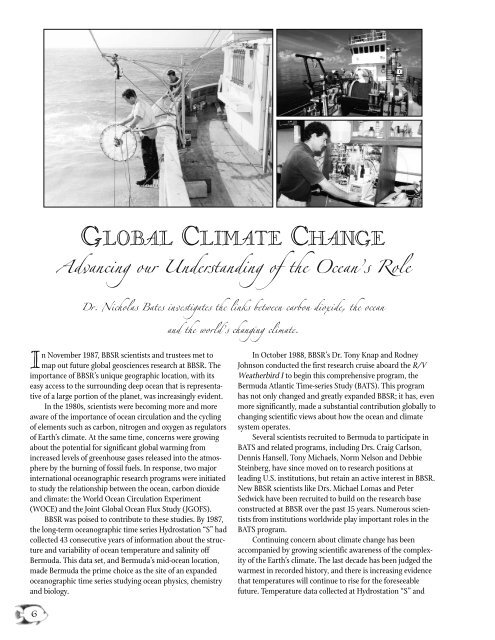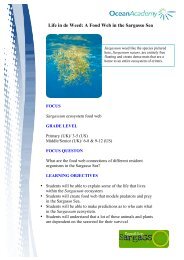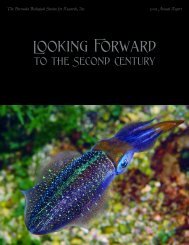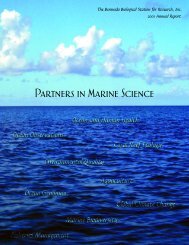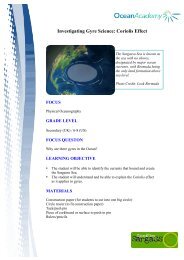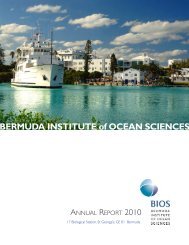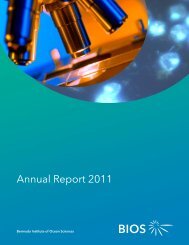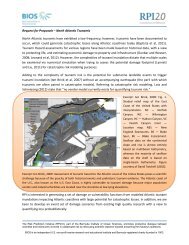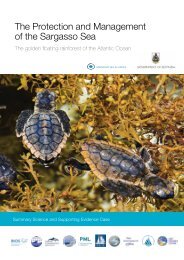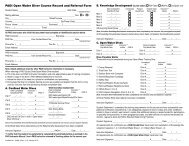In November 1987, <strong>BBSR</strong> scientists and trustees met tomap out future global geosciences research at <strong>BBSR</strong>. Theimportance <strong>of</strong> <strong>BBSR</strong>’s unique geographic location, with itseasy access to the surrounding deep ocean that is representative<strong>of</strong> a large portion <strong>of</strong> the planet, was increasingly evident.In the 1980s, scientists were becoming more and moreaware <strong>of</strong> the importance <strong>of</strong> ocean circulation and the cycling<strong>of</strong> elements such as carbon, nitrogen and oxygen as regulators<strong>of</strong> Earth’s climate. At the same time, concerns were growingabout the potential for significant global warming fromincreased levels <strong>of</strong> greenhouse gases released into the atmosphereby the burning <strong>of</strong> fossil fuels. In response, two majorinternational oceanographic research programs were initiatedto study the relationship between the ocean, carbon dioxideand climate: the World <strong>Ocean</strong> Circulation Experiment(WOCE) and the Joint Global <strong>Ocean</strong> Flux Study (JGOFS).<strong>BBSR</strong> was poised to contribute to these studies. By 1987,the long-term oceanographic time series Hydrostation “S” hadcollected 43 consecutive years <strong>of</strong> information about the structureand variability <strong>of</strong> ocean temperature and salinity <strong>of</strong>f<strong>Bermuda</strong>. This data set, and <strong>Bermuda</strong>’s mid-ocean location,made <strong>Bermuda</strong> the prime choice as the site <strong>of</strong> an expandedoceanographic time series studying ocean physics, chemistryand biology.6GLOBAL CLIMATE CHANGEAdvancing our Understanding <strong>of</strong> the <strong>Ocean</strong>’s RoleDr. Nicholas Bates investigates the links between carbon dioxide, the oceanand the world’s changing climate.In October 1988, <strong>BBSR</strong>’s Dr. Tony Knap and RodneyJohnson conducted the first research cruise aboard the R/VWeatherbird I to begin this comprehensive program, the<strong>Bermuda</strong> Atlantic Time-series Study (BATS). This programhas not only changed and greatly expanded <strong>BBSR</strong>; it has, evenmore significantly, made a substantial contribution globally tochanging scientific views about how the ocean and climatesystem operates.Several scientists recruited to <strong>Bermuda</strong> to participate inBATS and related programs, including Drs. Craig Carlson,Dennis Hansell, Tony Michaels, Norm Nelson and DebbieSteinberg, have since moved on to research positions atleading U.S. institutions, but retain an active interest in <strong>BBSR</strong>.New <strong>BBSR</strong> scientists like Drs. Michael Lomas and PeterSedwick have been recruited to build on the research baseconstructed at <strong>BBSR</strong> over the past 15 years. Numerous scientistsfrom institutions worldwide play important roles in theBATS program.Continuing concern about climate change has beenaccompanied by growing scientific awareness <strong>of</strong> the complexity<strong>of</strong> the Earth’s climate. The last decade has been judged thewarmest in recorded history, and there is increasing evidencethat temperatures will continue to rise for the foreseeablefuture. Temperature data collected at Hydrostation “S” and
BATS have documented a rise in ocean temperatures inresponse to changes in the atmosphere. These data haveprovided a new understanding about global ocean circulation,seasonal and year-to-year ocean variability, and the complexinteractions between the ocean and climate. Studies at <strong>BBSR</strong>supported by grants from the G. Unger Vetlesen Foundationand the Exxon Mobil Corporation have supplemented theresearch <strong>of</strong> these larger programs.New technologies developed since the 1980s have contributedto this understanding. <strong>BBSR</strong> scientists have aidedtheir development by deploying and recovering new technologiesin the ocean during their test phases. Satellite launchesand advances in computing power have enabled researchers torealistically simulate ocean and atmospheric circulation, andsmall-scale features such as ocean currents and eddies. Onesuch eddy <strong>of</strong> warm water had a significant effect on sea levelaround <strong>Bermuda</strong> for several weeks in<strong>2002</strong>.<strong>Ocean</strong> carbon dioxide (CO 2 ) data iscollected by <strong>BBSR</strong> scientists to understandhow the ocean absorbs CO 2 fromthe atmosphere and to predict how theocean might control atmospheric CO 2levels in the future. My research team at<strong>BBSR</strong> has collected the world’s longestdata set <strong>of</strong> oceanic CO 2 at the BATS site,providing an important record <strong>of</strong> therate <strong>of</strong> increase in oceanic CO 2 and themechanisms that control the uptake <strong>of</strong>CO 2 by the ocean. Norm Nelson and Iuse satellite imagery and BATS data tostudy the effect <strong>of</strong> hurricanes on oceanphysics and the exchange <strong>of</strong> CO 2 between atmosphere andocean.In the past decade, awareness <strong>of</strong> the importance <strong>of</strong>phenomena such as the El Niño-Southern Oscillation to globalweather and climate has grown. Another climate phenomenon,the North Atlantic Oscillation (NAO), causes variabilityin weather and climate over the Arctic and Europe, in particular.<strong>Ocean</strong>ic CO 2 data collected at BATS and by WOCE hasrevealed that changes in El Niño and NAO causes largevariability in the global ocean uptake <strong>of</strong> CO 2 . This becomesimportant in the context that during the last couple <strong>of</strong>decades, there has been a shift to an increased frequency <strong>of</strong> ElNiño events and a shift to a dominant NAO climate state.On societally relevant timescales (e.g., decades to centuries),oceanic biological processes sequester large quantities<strong>of</strong> atmospheric carbon, modulating the concentrations <strong>of</strong> CO 2in the lower atmosphere. Prior to the beginning <strong>of</strong> BATS in1988, the gravitational flux <strong>of</strong> particulate organic carbon fromContinuing concern aboutclimate change has beenaccompanied by growingscientific awareness <strong>of</strong> thecomplexity <strong>of</strong> the Earth’sclimate.the sunlit upper ocean to the deep ocean, the “biologicalpump,” was thought to dominate biological storage <strong>of</strong> CO 2 .But <strong>BBSR</strong> scientists have shown that other mechanisms areimportant and significant to the biological pump <strong>of</strong> carbon tothe ocean interior. For example, research in <strong>Bermuda</strong> by <strong>BBSR</strong>alumni Craig Carlson and Dennis Hansell has shown that thetransfer <strong>of</strong> dissolved organic carbon to the ocean interior is animportant component <strong>of</strong> the ocean carbon cycle. Research at<strong>BBSR</strong> by Debbie Steinberg has also shown that zooplanktonthat migrate every night through the water column alsotransfer carbon to the deep ocean. Michael Lomas is nowstudying the variability <strong>of</strong> the phytoplankton community atBATS in relation to variability <strong>of</strong> climate phenomena such asNAO.Historically, biologists and geochemists have been atodds about whether nitrogen or phosphorus limits primaryproduction in the ocean. From research<strong>of</strong>f <strong>Bermuda</strong>, it has now emerged thatatmospheric nitrogen, fixed by oceanphytoplankton, and dissolved iron areimportant for controlling primary productionand the transfer <strong>of</strong> CO 2 fromthe surface ocean to the deep. Studies at<strong>BBSR</strong> in the 1980s and 1990s by JimGalloway, Tim Jickells, Tony Knap, FredLipschultz and Tony Michaels, amongothers, focused attention on the importance<strong>of</strong> atmospheric nitrogen fixation,prompting new research efforts on whatcontrols oceanic primary productivity.The importance <strong>of</strong> dissolved iron as anutrient element for phytoplankton isnow being investigated at <strong>BBSR</strong> by Peter Sedwick.Understanding how CO 2 is transferred from the ocean’ssurface to its interior remains an important scientificquestion, particularly if there are future changes in oceanstructure and circulation. BATS research will continue, providingnew opportunities to decipher complex interactionsbetween ocean biology and physics. New internationalprograms are emerging to investigate the transfer <strong>of</strong> greenhouseand non-greenhouse gases between the ocean andatmosphere. <strong>BBSR</strong> is poised to play a major role in theseprograms.The advances in global geosciences research at <strong>BBSR</strong>since the 1987 long-range planning workshop are among<strong>BBSR</strong>’s most important contributions in its first century andhave greatly enhanced our understanding <strong>of</strong> the ocean’s rolein climate. As in 1987, <strong>BBSR</strong> hopes that its existing role inglobal research will be the guide for participation in thesefuture oceanography and climate research programs.Left: Drs. David Menzel (left) and William Sutcliffe collect samples during a Hydrostation “S” cruise in the late 1950sUpper right: Crew members check the winches on the upper deck <strong>of</strong> the R/V Weatherbird II as it cruises to the <strong>Bermuda</strong> AtlanticTime-series Study (BATS) site 50 nautical miles southeast <strong>of</strong> <strong>Bermuda</strong> in the Sargasso SeaLower right: Senior Research Scientist Dr. Nicholas Bates measures the alkalinity <strong>of</strong> a seawater sample collected at the BATS site7


